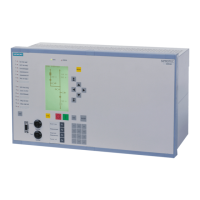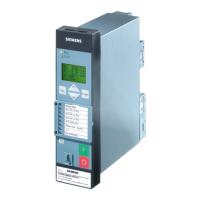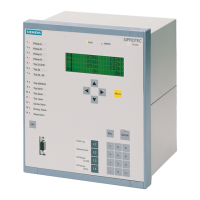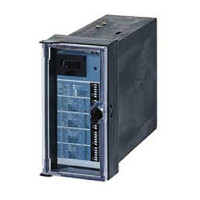•
In-rush restraint with second harmonic current quantities
•
Instantaneous tripping by any overcurrent element upon switch onto fault is possible.
Directional Time Overcurrent Protection 67, 67N
•
Four elements each for phase and ground operate in parallel to the non-directional overcurrent protec-
tion elements. Their pickup values and time delays can be set independently of these
•
Direction determination with cross-polarized voltages and voltage memory and dynamically unlimited
direction sensitivity
•
Fault direction is calculated phase-selectively and separately for phase faults, ground faults and summa-
tion current faults.
Dynamic Cold Load Pick-up Function 50C, 50NC, 51C, 51NC, 67C, 67NC
•
Dynamic changeover of time overcurrent protection settings, e.g. when cold load conditions are recog-
nized
•
Detection of cold load condition via circuit breaker position or current threshold
•
Activation via automatic reclosure (AR) is possible
•
Activation also possible via binary input.
Single-Phase Overcurrent Protection
•
Evaluation of the measured current via the sensitive or insensitive ground current transformer
•
Suitable as differential protection that includes the neutral point current on transformer side, generator
side or motor side or for a grounded reactor set
•
As tank leakage protection against abnormal leakage currents between transformer tanks and ground.
Voltage Protection 27, 59
•
Two element undervoltage detection via the positive-sequence system of the voltages, phase-to-phase or
phase-to-ground voltages
•
Choice of current supervision for 27-1 and 27-2
•
Two-element overvoltage detection via the positive sequence system voltages, negative sequence system
voltages, phase-to-phase or phase-to-ground voltages
•
For a single-phase connection, the connected single-phase phase-to-ground or phase-to-phase voltage is
evaluated
•
Settable dropout ratio for all elements of the undervoltage and overvoltage protection.
Negative Sequence Protection 46
•
Evaluation of the negative sequence component of the currents
•
Two definite-time elements 46-1 and 46-2 and one inverse-time element 46-TOC; curves of common
standards are available for 46-TOC.
Motor Starting Protection 48
•
Inverse time tripping characteristic based on an evaluation of the motor starting current
•
Definite time delay for blocked rotor.
Introduction
1.3 Characteristics
26 SIPROTEC 4, 7SJ62/64, Manual
C53000-G1140-C207-8, Edition 08.2016

